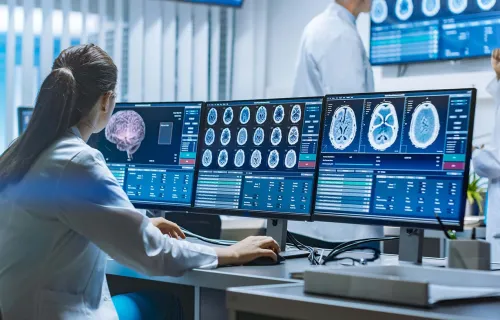In the latest episode of our Energy Transition Talks podcast series, Peter Warren sits down with Vice-President, CGI Global AI Research Lead Diane Gutiw to discuss generative AI and its global impact across industries. In part one of the conversation, they delve into the inevitability of AI in everyday life, the need for a structured, secure approach when using these tools and the use cases that are helping organizations improve efficiency and secure a quick return on their AI investment.
AI is inevitable (but requires guardrails)
The burgeoning conversation surrounding generative AI is one of the hottest topics for organizations globally. Questions pertaining to the inherent business opportunities and challenges are emerging at the same rate that organizations strive to define, harness and govern these new technologies.
According to CGI’s AI expert Diane Gutiw, one thing is not up for debate: “AI is inevitable.”
She sees the current AI landscape as similar to the adoption of the internet. “I think we're really going to be leveraging AI when we start to forget that it's there and are able to understand, have transparency into its processes and discern what's being delivered to us.”
However, Diane stresses that AI is not an end in itself. Especially in a business context, she explains, it is a tool developed to serve an intended purpose. “As long as we put the guardrails in place for responsible development, use and build-out of these tools, the power and the opportunities are unlimited.”
Data and methodology parameters keep generative AI secure and focused
Peter shares that a recent IDC session revealed that the number one concern for CEOs and CIOs is where AI is headed, what kind of data is going into it and how secure it will be.
Part of the fear, Diane suggests, stems from the fact that open models are so publicly accessible, making it difficult to identify what information was used to train a technology or the source of its output.
She illustrates: “If you're using a public model, it's no different than using a public forum as a developer looking for advice, but you don't share your sensitive information in that public forum.”
In a business context, Diane recommends using the same privacy and containers for data and information used for sharing sensitive information: “Once you lock down the data in a secure and safe environment within a secure cloud with all of the security protocols, you can still leverage the incredible power of these generative AI solutions, but nothing goes back out and nothing comes in.”
In this way, organizations can “constrain the parameters” so models are focused on a given problem. This is part of a structured approach to generative AI that Diane recommends organizations adopt to avoid ‘AI for the sake of AI.’
“Having a focused approach in the implementation is going to help organizations start to leverage and accelerate their AI journeys, and scale with a purpose in mind. That’s also critical to getting a return on your investment.”
Generative AI use cases: bridging knowledge gaps and improving efficiency
Although the energy and utilities industry has been using machine learning for a long time to optimize asset systems and routing vehicles, for example, Peter says that a return on investment is key for many decision-makers when it comes to AI. Often this is because the business value of AI tools isn’t immediately evident.
So where can organizations find quick value with generative AI?
As Diane explains, the ‘amazing power of generative AI’ is its ability to leverage unstructured data, narrative data and lots of different media.
In her view, the best use of generative AI ‘immediately out of the box’ is focusing on manual activities where information searching costs a great deal of time. “It’s a very, very rapid return on investment because you can focus it just on the documents and information you want, for example, guidelines for call centers, policy development or contracts.”
One use case she points to is baby boomer retirement, which will see 40% of the workforce retire in the next five to ten years, leaving a legacy knowledge gap covering the last half century. AI tools can mine information across multiple documents and unstructured data and incident databases very rapidly and provide answers to questions that someone would have known just from experience.”
When it comes to technical maintenance of assets working together on the grid, for example, this could involve mining all the technical manuals, PDFs, Word documents, available training and past incidents to contextualize information and obtain a quick answer, saving time and effort. Further, the tool can advise on the next best action.
For Peter, this means faster uptime for repairs and enhanced efficiency within the energy and utilities industry.
One use case on the rise is code modernization, as generative AI tools inherently understand programming languages. The ability to extract metadata or move code into a more modern format, Diane says, is ‘revolutionary.’
Ultimately, she says, generative AI needs to be case-driven and purpose-led: “Generative AI is a great tool, but it’s not the answer to every problem.”
Listen to part two of the discussion here.
Listen to other podcasts in this series to learn more about the energy transition
Read the transcript:
- 1. Introduction
-
Peter Warren:
Hello, everybody, and welcome to another installment of our energy and transition talks. Today, we're focusing on AI specifically and around generative AI and what this means, how the best practices and how we're actually going to apply this to the energy transition marketplace. This will be a two-part session. Today, starting out in part one and visiting me again in part two is probably the busiest person in CGI right now, we were just talking about that, is Dr. Diane Gutiw, our head of AI and CGI. Would you want to say hello, Diane?
Diane Gutiw:
Hi. Great to meet with you again, Peter, and have this conversation.
Peter Warren:
Thank you. We did one of these a few weeks back, actually almost a couple of months back, I guess, now, where we talked about data and the importance of data here, and I'm sure we're going to get into it. I know you've just done a couple of big presentations to some of our larger customers on this, but a lot of people have questions about AI.
- 2. AI is inevitable but requires guardrails
-
Should we be afraid of AI? How do we manage the risk? What's coming next? What are your thoughts on all of that?
Diane Gutiw:
It's a great question, and it's probably a question we get both inside and outside of work as we dig deeper into AI. AI is inevitable, and we've been using it in all of our interactions and household events. Anyone that orders anything off of Amazon, anyone who's on social media who wonders why when you have a conversation about a canoe, suddenly every canoe ad comes up in your Facebook and Instagram. These are fantastic tools that have been used to serve us information that these platforms think we need or to prepare packages to be closer to us, so we're able to get that next-day delivery. AI is inevitable. We're going to start to see it embedded into all of our day-to-day productivity tools, and it's a tool. I think, very similar to the adoption of the internet, I think we're really going to be leveraging AI when we start to forget that it's there and understand and have transparency into the processes and become discernible in what's being delivered to us, very similar to how we use the internet and know what's trustworthy.
When we are looking at AI in a business context, again, remembering it's just a tool, that we developed the tool to meet the purpose that we intend, and as long as we put the guardrails in place for responsible development, use, and build out of these tools, the power and the opportunities are unlimited, as well as being discerning and knowing what kind of technologies we need to debunk the things that aren't true, that are false, that could be harmful are also very important and big opportunities. No, I don't believe we need to be afraid of AI, but I do think that we need guardrails in place. It is absolutely inevitable that AI is going to become more and more prevalent in our day-to-day lives, and becoming discerning individuals in what we see as important.
- 3. Data and security considerations for organizations using AI
-
Peter Warren:
Maybe I could add to that. I was at a session a few weeks ago in Toronto with the IDC presenting and they had their sort of research that they had done. They talked about how CEOs and CIOs, their number one concern is where is this AI going to be, what kind of data is going to it, and how secure is that? Any thoughts on those two points?
Diane Gutiw:
Yeah. When we've done a lot of work around that, part of the fear with that is the open models that are so publicly accessible, it's really hard to have the transparency to see what that information was trained on or the source of the output it's feeding you back. When we look at it in a business context, I think we need to really use the same type of data and information privacy and the containers we use with our own information sharing with sensitive information. If you're using a public model, it's no different than using a public forum as a developer looking for advice or looking for input on something, but you don't share your sensitive information in that public forum. Once you lock it down in a secure and safe environment within a secure cloud with all of the security protocols, you can still leverage the incredible power of these generative AI solutions, but nothing goes back out, nothing comes in. You can constrain the parameters so it's really focused on the problem you're addressing, and that's really key to the question, I think, and the answer.
Peter Warren:
Yeah. I know when I was learning structured programming many moons ago, so that shows you how old I am, is that I was always looking at the outcome in mind and then looking forward. I think a lot of people unfortunately are approaching this as if they've got a shiny new hammer and they go, "Oh, what can we hit with this?" They're all excited about doing something with it, and then they're looking at suddenly, they've got themselves caught up in the issues that come out from that repercussions of just jumping into it. Your suggestion is following a bit more of a structured approach. Do you want to cover that off briefly for us?
Diane Gutiw:
Well, I think it's really critical that we're not just developing AI for the sake of AI. If we have a problem that we're trying to solve that's a good data solution or a good AI solution that may be able to address it, you start with what's that problem, and that helps you start to contain the information and the models you use. It's a good point. Generative AI is a great tool, but it's not the answer to every problem. If you start with what's the question you're trying to answer, then look at what information is needed, you can start to then systematically develop now what model am I going to use to use this information to get the output I'm looking for? Having a focused approach in your implementation is really going to help start organizations being able to leverage and accelerate their AI journeys, and scale it with a purpose in mind. That's also really critical to getting a return on your investment for what you're developing in AI.
Peter Warren:
I think it's all about de-risking and those sort of things, and I think that, again, where people have sort of jumped into it.
- 4. Use cases to help identify the real value and quick wins of AI
-
Peter Warren:
One of the gentlemen I saw when I was actually at the Enlit Europe event, which is a huge utility event, last week in Paris, one group was talking about even using personal assistants for helping the workforce be more efficient in the workforce, and then 20 minutes later we ran into somebody that says, "Oh, I'm not going to do anything with AI. I don't understand the value of it." There's a real dichotomy of people, but what's your thought on that, the use of personal assistants, and why are some people still being maybe I don't see the benefit of this?
Diane Gutiw:
Well, again, it's really what is the problem you're trying to solve? A great use case in that personal assistant or expert advice would be a contact center. There's a lot of legacy knowledge that's retiring with us baby boomers, or maybe you baby boomers. I'm not quite a baby boomer, but with the generation that's retiring, 40% of the workforce is going to retire in the next 5 to 10 years, and the new incoming workforce don't have that legacy knowledge of the last 40, 50 years that's going out with the retirees.
By using these tools to mine information across multiple documents and unstructured data and incident databases very rapidly and provide answers to questions that someone would have known just from experience is really a groundbreaker in these personal assistants. There's lots of use even simply and I need to come up with a wording for my out of office or help me design my whatever. I think there's some good uses with that, as well, where it can give you some insights and some value and past information, but I think the real targeted, being able to provide rapid information to knowledge across multiple different types of media, is really where we're starting to see that quick value.
Peter Warren:
I think that's a quantum jump. I think the energy and utility industry has been using machine learning for a long time to optimize asset systems, even routing of vehicles and things like that, but I think this idea of looking at unstructured data and being able to bring it forward, I think one of the things you said before, AI isn't going to make a dumb person smart, but it can definitely make a smart person more efficient, if I quoted you right. Maybe you can correct me where I go wrong on that one. But the idea here is really all that unstructured data is now a resource to it and health and safety, safety, safety, safety, and ensuring the grid or ensuring the pipelines that our customers bring forward is the key factor. They can't know all the stuff and all that unstructured data all the time, so having it there in time and in this situation is really what you're saying is now coming forward with this type of tool?
Diane Gutiw:
Well, absolutely. Another great use case when you talk about assets is the number of technical manuals for all of these assets that work together on the grid. It's just a huge amount of information that someone would have to mine through if you're relatively new, if you're replacing someone, or if it's an asset that doesn't often fail. If you had all of those technical manuals and PDFs and Word documents and training that's available, as well as past incidents, and you were able to bring back that information in context, then you've saved yourselves all of that manual effort of going to look for it, and you've provided not only an answer to your question, but then you can have that interaction on now, what's my next best action? That's the amazing power of generative AI, that's what's blown us all away, is unstructured data, narrative data and lots of different media was always hard. The other thing that is coming quickly is the ability now to use images and be able to say, "What's this thing?" or, "What's wrong with this thing?" as another tool, and be able to get the feedback very quickly on things that, again, you would turn to somebody with 40 50 years experience and say, "Hey, what's this thing?"
Peter Warren:
Yeah. I think driving efficiency, you just talked about everything you said would mean faster uptime for repairs. Our industry has a concept of a compatible units, meaning this transformer versus that transformer, but maybe they are radically different connection points from one than the other. Having that sort of brought forward, I can definitely see that, but you don't deal in just our industry. I know you were just talking to one of our big telco providers, customers, the other day, insurance industry, banking. What do you see that this industry might be able to use for customer service or just improving how they perform?
Diane Gutiw:
I think there's a lot of use cases that go across multiple different industries, and focusing on those manual activities where we lose time in searching for information. That, to me, is the best use of generative AI immediately out of the box. It's a very, very rapid return on investment because you can focus it just on the documents and the information that you want. It can be anything from, as we said, technical manuals and guidelines for contact centers, but also for policy development, for contracts, anything that requires you to go back and look through lots of different information for context. It pulls that information together incredibly rapidly, and those are the sorts of use cases. The other one that has been really taking off is code modernization, because inherent in these generative AI tools is the ability to understand programming languages like FoxPro and COBOL, where there's less and less skills, and you can say, "What was this piece of code doing?" You can extract metadata, which has always been a hard manual task, and you can also ask it to move the code into a more modern format, and that functionality comes right with these generative AI tools, which is revolutionary.
Peter Warren:
That's brilliant. You're telling me I have to rethink my retirement plans on going back to programming COBOL and some of it might be different?
Diane Gutiw:
Well, it's funny, I saw a good joke on that. There still needs to be somebody that can validate what it comes up with is accurate, so that one COBOL programmer still has a job, I think, Peter.
- 5. Key takeaways and stay tuned for part two
-
Peter Warren:
There's good news for me. I think the idea is, so you've covered a lot of ground, people shouldn't be afraid of this. It's understanding what they're trying to deal with, understanding do they have access to the data, we talked about that in the previous call, and then looking for the tool, I think is what you're saying. A lot of people are starting with the tool and then trying to find the data and then saying, "What can I do with it?" They're doing it exactly backwards. Just as we wrap up this part of the episode and we'll pick it up in episode two, what's your thoughts on that, looking at it in the right direction?
Diane Gutiw:
Well, I think it's a use case. It needs to be use case-driven. You need to know what your purpose is. Sometimes it's a predictive model. I need to be able to forecast or predict and prescribe something which will help you inform what AI model. Generative AI has some very clear use cases that it may very easily be we want this use case and this tool hand-in-hand, but I think it's important not to limit ourselves to assuming that every chatbot now needs to have generative AI. Depending on the use of and the need and the questions you're asking, the type of technology, the cost associated with that technology, as well as the type of data it needs to consume, needs to be considered. It all comes to that return on investment. If you can do something simply, it always makes sense to do something simply.
Peter Warren:
I think ROI is the big point, definitely in this industry, it's important. We'll wrap up today. Thank you very much, Diane, and we'll pick this up in episode two, where we're going to explore a little bit more what this means specifically for the energy transition. Thank you very much. Thank you, Diane.
Diane Gutiw:
Great. Thanks, Peter








